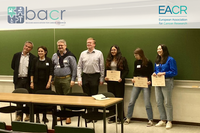NARILIS PhD student Shalini Iyer awarded best poster prize at BACR annual meeting 2023!
Shalini Iyer is a talented PhD student from India, pursuing her doctoral research at UNamur-NARILIS under co-supervision by Prof. Anne-Catherine Heuskin (LARN) and Prof. Carine Michiels (URBC). Her work in the field of cancer immunology is supported by a Télévie grant from the FNRS. The focus of her PhD thesis is on the reprogramming of tumor-associated macrophages through gold nanoparticles and proton irradiation to improve cancer radiotherapy. Shalini explores ways to shift macrophages towards the M1 pro-inflammatory and anti-tumor phenotype, redirecting their function to fight against cancer instead of aiding its growth.
On the 27th of October 2023, Shalini Iyer had the opportunity to present her ongoing studies at the Annual Meeting of the Belgian Association for Cancer Research (BACR), hosted this year by UCLouvain in Brussels. Her poster communication entitled “Using gold nanoparticles and protons to improve immune responses in radiotherapy” was awarded a best poster prize!
Shalini's work is further detailed in the abstract below.
Picture: Shalini Iyer is the third from the right.
Using gold nanoparticles and protons to improve immune responses in radiotherapy
Shalini Iyer (1,2), Carine Michiels (2), Anne-Catherine Heuskin (1)
(1) Laboratoire d’Analyse par Réaction Nucléaire (LARN), University of Namur, Belgium;
(2) Unité de Recherche en Biologie Cellulaire (URBC), Namur Research Institute for Life Sciences (NARILIS), University of Namur, Belgium
Presenting author : Shalini Iyer - University of Namur, Physics Department - NARILIS, LARN laboratory, Physics Department, 61 Rue de Bruxelles, Namur, Belgium - shalini.iyer@unamur.be
Radiosensitivity of cells has been observed to be enhanced by the use of metallic nanoparticles via an increase in the intracellular reactive oxygen species (ROS) and emitted secondary electrons and can potentially improve the outcome of radiotherapy for cancer patients. Gold nanoparticles (AuNP) are also capable of independently increasing the ROS in cells, thereby blocking pro-tumor M2 polarization in macrophages. Combining these strategies, this study employs AuNP stabilized and functionalized with different polymers, polyethylene glycol (PEG) or functionalized polyvinylpyrrolidone (PVP), of sizes 15 or 50 nm in diameter. These AuNPs were found to have a high coating density (60-70% w/w) and stability. On adding these AuNPs to M2 macrophages, no toxicity was observed even at high concentrations, and the AuNP-PVP were readily endocytosed by the macrophages, but not AuNP-PEG. We also found that AuNP-PVP aids in promoting the M1 pro-inflammatory phenotype, while AuNP-PEG promotes the M2 phenotype. Ongoing work includes exposing the AuNP-internalized M2 cells to X-ray (5 and 10 Gy) and proton irradiation followed by assessment of ROS and phenotype alteration. In vivo effects will then be investigated on C57BL/6J mice to ascertain the translation of the AuNP only and AuNP+radiation approaches in the treatment of cancer.
 NAmur Research Institute for LIfe Sciences
NAmur Research Institute for LIfe Sciences


